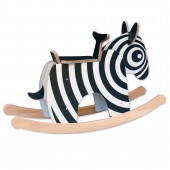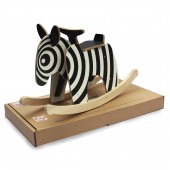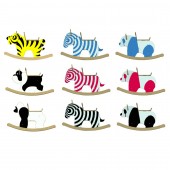
| THE AWARD |
| CATEGORIES |
| REGISTRATION |
| SUBMIT YOUR WORK |
| ENTRY INSTRUCTIONS |
| TERMS & CONDITIONS |
| PUBLICATIONS |
| DATES & FEES |
| METHODOLOGY |
| CONTACT |
| WINNERS |
| PRESS ROOM |
| GET INVOLVED |
| DESIGN PRIZE |
| DESIGN STORE |
| THE AWARD | JURY | CATEGORIES | REGISTRATION | PRESS | WINNERS | PUBLICATIONS | ENTRY INSTRUCTIONS |
Rocking Zebra Toy by Newmakers |
Home > Winners > Design #26497 >Interview |
 |
|
FS: What is the main principle, idea and inspiration behind your design?
DC: We wanted to re-imagine the classic rocking horse, with a modern, exotic, twist. The new product needed to be visually striking; modular, to allow for different character types; flat-pack for internet sales and shipping; and affordable.
FS: What has been your main focus in designing this work? Especially what did you want to achieve?
DC: We wanted to bring production back to the UK. Therefore a great deal of effort was spent on production and materials issues. It was imperative to reduce part numbers, and production steps, drastically in order to ensure an acceptable price-point. One major result of this is our discovery, and use, of custom-print laminate surfaces for the pattern/color parts. This means we actually apply all pattern before cutting takes place, meaning virtually no post-finishing is necessary.
FS: What are your future plans for this award winning design?
DC: Newmakers is a young and small company. Winning this world-renowned prize will give us credibility with both industry, and consumers. Credibility is crucial in allowing us to expand our accessibility to global buyers.
FS: How long did it take you to design this particular concept?
DC: From first idea, to finished product: about four years, and five different pre-production runs.
FS: Why did you design this particular concept? Was this design commissioned or did you decide to pursuit an inspiration?
DC: When I made the first one, it was an elephant. I was living in Chiang mai, northern Thailand at the time, and had been to an elephant sanctuary with some German friends who were visiting. A few days later, I was in my workshop, between projects, and just started playing around with some ideas.
FS: Is your design being produced or used by another company, or do you plan to sell or lease the production rights or do you intent to produce your work yourself?
DC: This, and all future products will be marketed and sold under our own Newmakers brand.
FS: What made you design this particular type of work?
DC: I have designed nany different types of product in my career; medical goods, mobile phones, industrial layouts, furniture & lighting. The one area I had never touched on was kids products. It now turns out that this is what I enjoy making the most!
FS: Where there any other designs and/or designers that helped the influence the design of your work?
DC: Not really. However I do think that my professional experience in Germany influenced the production rational greatly, and my time in Asia certainly influenced the materials choice and overall graphic image (particularly Japan and Korea design).
FS: Who is the target customer for his design?
DC: Design-aware parents, who want something that is as good looking as it is fun. I also think those that value good workmanship, and honest materials use will find something to please them.
FS: What sets this design apart from other similar or resembling concepts?
DC: It is a very contemporary take on a classic heirloom toy. Plus it packs down to a very compact carton size. The laminate surfaces are also super-tough, making them virtually impossible to scratch.
FS: How did you come up with the name for this design? What does it mean?
DC: It's a Zebra, and it Rocks!
FS: Which design tools did you use when you were working on this project?
DC: I use some very old, very basic 3-D software, plus an equally old graphics program. Apart from that it's just the usual workshop equipment to make the prototypes.
FS: What is the most unique aspect of your design?
DC: I think the laminate surfaces are pretty unique; the fact that it is modular - we just need to change a couple of parts to produce a Panda, Gorilla, Tiger... 80% stays the same. Also it is very compact in the carton.
FS: Who did you collaborate with for this design? Did you work with people with technical / specialized skills?
DC: The design and prototyping I do myself. The production is were I always look for the best advice possible. We have access to a terrific CNC workshop who do the cutting for us, and their advice and suggestions have been invaluable.
FS: What is the role of technology in this particular design?
DC: Although this product looks quite simple, actually we do work to tolerances of 0.2mm in order to ensure everything fits perfectly. Therefore CNC cutting technology is crucial. Also the laminate surfaces need to be very accurately produced. So yes, technology is actually very important in this product.
FS: Is your design influenced by data or analytical research in any way? What kind of research did you conduct for making this design?
DC: No. We are not a research-led company. The most important research activity for us is letting kids loose on the prototypes and watching what they do, and whether they have fun.
FS: What are some of the challenges you faced during the design/realization of your concept?
DC: Production issues have been a major challenge. In order to manufacture in the UK, we need to maximize the number of parts per sheet to the extreme, drastically reduce production steps, and automatize as much as possible. This took a lot of time and effort.
FS: How did you decide to submit your design to an international design competition?
DC: In the past, I have been fortunate to receive a number of major awards for previous work. I know how important this recognition is in promoting yourself, or your work, as being seriously credible and of real value in a crowded marketplace.
FS: What did you learn or how did you improve yourself during the designing of this work?
DC: This project took four years, one of the longest I have ever done. It taught me more patience, and also that the system behind the product was of equal, or greater, importance that that individual product itself.
FS: Thank you for providing us with this opportunity to interview you.
A' Design Award and Competitions grants rights to press members and bloggers to use parts of this interview. This interview is provided as it is; DesignPRWire and A' Design Award and Competitions cannot be held responsible for the answers given by participating designers.
| SOCIAL |
| + Add to Likes / Favorites | Send to My Email | Comment | View Press-Release | Translations |





